

Biodiversity
Action
Plan
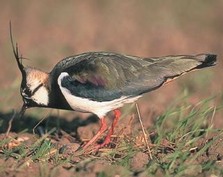
Lapwing have a slow, flappy flight of flickering black and white and ‘pee-wit’ call; in spring, males display in a tumbling flight.
Lapwing breed and over-winter in Barnsley although land drainage and agricultural intensification has reduced farmland numbers. It is now found in the Dearne Valley and on upland pastures.
Lapwing feed on invertebrates including worms and larvae found in grazed pasture and wetlands.
Conservation includes:
- open wet grassland with a short sward for nesting and tussocks for cover
- Wet muddy areas and pools for feeding
- Anti-predation measures
- Avoidance of disturbance
Habitats
- Floodplain Grazing Marsh
- Neutral or Acid Grassland
- Rush Pasture
- Arable fields + ‘Lapwing plots’
Lapwing nest on bare ground and in short plant cover (<5cm).
They nest in in open wet grass-lands with a very short sward (<5cm), tussocks 10-15 cm) for cover, and pools and muddy areas for Feeding. They avoid trees and hedges.
They have one brood a year from late March to early June. Too early mowing or grazing destroys nests; overstocking with cattle can lead to nests being trampled.
Lapwing
Resident breeding bird
UKBAP 2007 Priority Species
NERC Section 41 Species of Principal Importance
BoCC5 Red List [IOCN2 VU]
Redshank have distinctive bright orange-red legs. Often seen feeding in shallow water, probing their bills into the mud, they fly off with a cry, flashing white .
Redshank breed in Barnsley. Land drainage has reduced the small upland numbers however it is found in Dearne Valley wetlands
Decline due to drainage, re-seeding, fertilising of grassland.
Conservation includes
- open wet grassland with varied sward for nesting sites
- Wet muddy areas and pools for feeding
- Anti-predation measures
- Avoidance of disturbance
Habitats
- Floodplain Grazing Marsh
- Wet grassland
- Rush Pasture
Redshank
Resident breeding bird
Scarce and localised in Barnsley
BoCC5 Amber List
Redshank feed on invertebrates: insect larvae, earthworms.
They nest in wet grassland, with a varied sward, near standing water and muddy areas for feeding.
They have one brood a year from April to mid .June. Too early mowing or grazing destroys nests; overstocking with cattle can lead to nests being trampled.
Snipe, a stocky, brown well- camouflaged bid, has a long straight bill, and typically a drumming display flight.
Although a passage winter visitor, Snipe breed in Barnsley from April to July in upland areas and to some extent on lowland wetlands.
Snipe feed mainly on earthworms, leatherjackets, beetles and caterpillars with the young fed on earthworms.
Conservation includes:
- Retain/create wet ground with scrapes/shallow water
- Create/retain shallow water
- Maintain taller and shorter vegetation by light grazing and annual rush cutting
- Minimise disturbance in breeding season
Habitats
- Upland flushes and boggy heath
- Rush Pasture, Grazing marsh, + wet grassland.
Snipe, Common
BoCC5 Amber List [IUCN2 VU]
Moderate decline in last quarter century but steep decline in lowland wet grassland
Snipe breed on wet flushes on moorland, damp pasture and near the edges of standing water.
Snipe nest on wet tussocky ground with vegetation with both shorter grass and quite tall grasses and rushes. Small field corners may support Snipe
They also need soft, damp soil &/or shallow, muddy-bottomed pools, close to cover, to feed.
Ringed Plover, a small, short-legged wader, with a brown back, white underparts and a black collar and face markings.
Its orange bill, tipped with black, orange legs, white wing-stripe and no yellow ring around its eye, distinguishes it from the Little Ringed Plover.
They feed on insects and other aquatic invertebrates.
Conservation measures:
- Retention of suitable habitat
- Prevention of sites being overgrown
- Managing water levels
- Improving grazing regimes, prevention of disturbance
Habitats
- Previously developed land
- Land prepared for development
- Wetlands
Ringed Plover, which nests around the coast, have now begun breeding inland in pits and former industrial sites. Its numbers have severely declined.
The nest is a shallow scrape, lined with stones, with 1 to 3 broods April to September.
Weather,predation, disturbance, often lead to nest failure, and nesting habitat in Barnsley is often transient and conservation difficult to achieve.
Ringed Plover
Breeding bird,
BoCC5 Red List [IUCN2 VU]
Little Ringed Plover
A small, short-legged wader, with a distinctive black and white head pattern. It is similar to the Ringed Plover, but it has black bill, pale, brown legs, and a yellow ring around the eye,
Nests are found on level areas of stony ground, little or no vegetation and normally close to shallow water, with muddy edges for feeding on insects and aquatic invertebrates. They produce 1 or 2 broods from April to September.
Conservation measures:
- Retention of suitable sandy or gravelly habitats with access to pools
- Prevention of sites becoming overgrown
- Protection from disturbance and predation
Habitats
- Previously developed land
- Land prepared for development
- Wetlands reserves
- Upland reservoir stony margins
A scarce summer visitor to the UK, the Little Ringed Plover increased numbers in Barnsley, exploiting local manmade habitats: coal waste shale and former sidings rail ballast, with subsidence pools forming suitable feeding areas,
As these post-industrial sites were landscaped or built on, LRPs use other transient brownfield sites, wetlands reserves in the Dearne Valley, and possibly upland reservoir edges.
Little Ringed Plover
Migrant breeding bird
Schedule 1
BoCC5 Green List
Ten pairs // less than 15
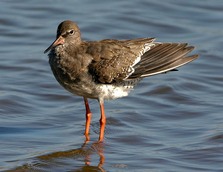
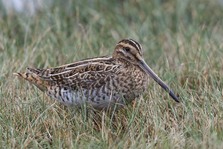
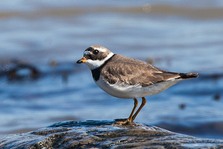
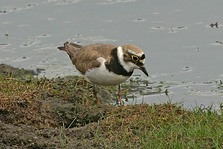
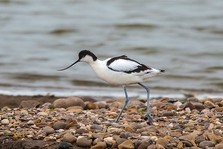
Avocet
Schedule 1
BoCC5 Amber List - due to localised distribution
Avocet, a distinctive black and white wader, it sweeps its long, up-curved bill from side to side through water or loose sediment to locate hidden prey.
Avocets have only recently bred in Barnsley - in the Dearne Valley wetlands as a result of the conservation measures there.
Avocets feed on aquatic invertebrates by wading in shallow water.
Conservation measures
- Maintaining wetland shallow water and bare ground
- Preventing sites being overgrown
- Managing water levels
- Reducing predation
Habitats
- Shallow standing water with ample invertebrate prey
- Bare or sparsely vegetated areas near shallow standing water in breeding season
Avocet nest on open ground close to water, often in small groups.
It has one brood of 3-5 eggs, using shallow lined scrape on bare mud, gravel or sparse vegetation.
The numbers nesting depends on the availability of suitable nest sites, distance to water and risk of predation.
Wetland birds - waders
Several priority species of waders breed on wet grassland or marshy areas, in lowland wetlands in Barnsley or on the moorland fringe. However drainage and agricultural improvement have reduced the upland breeding opportunities. Breeding waders need open areas away from hedges and trees, a varied, patchy sward with tussocks for nesting and cover, and wet, muddy areas for feeding.
Curlew, a large mottled brown-grey wader, it has a long beak curved down, and a distinctive carrying call. In flight its white wedged rump is visible.
Curlew come to Barnsley in April to breed on the moors and upland rough wet grasslands, with some in lower areas.
Curlew feed in rough damp tussocky pasture. Adults use their long bills to probe for worms, leather-jackets and other invertebrates.
Conservation measures
- Maintain rough, damp grassland; restrict drainage
- Control grazing to give taller vegetation for nesting cover
- Provide damp areas etc for chick feeding
- Avoid disturbance in breeding: delay cutting until after July
Habitats
- Acid and Neutral Grassland
- Rush Pasture
See also upland birds
Curlew
UKBAP 2007 Priority Species
NERC Section 41 Species of Principal Importance
BoCC5 Red List [IUNC2 EN]
General protection W&C Act
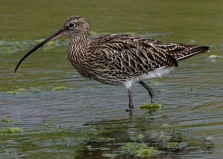
Curlew nest in rough grassland, with some tall vegetation, scattered tussocks and rush patches, and damp areas.
They usually have one brood, with a second if the first one fails. Young birds fledge in late June or July. Chicks feed on surface insects and spiders.
Drainage, ‘improvement’ of grasslands, tree planting, disturbance and predation cause declines.
The UK Breeding Water and Wetland bird populations indicator include several waders in the ‘Wet Meadow species’ section: Curlew, Lapwing, Redshank, Snipe, all Local Priority Species. As well as the Local Priority Species, other waders that breed in Barnsley include Oystercatcher, and Golden Plover and Dunlin on upland moors.
Sites that support a significant proportion of Barnsley’s breeding or wintering waders are also a conservation priority.
Wetland birds